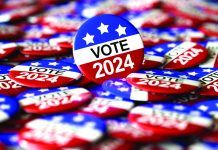Downtown Third Avenue may be getting a facelift and residents are questioning the need.
At a Monday board meeting held by civic group Crossroads II, city staff from the engineering and planning departments answered questions from concerned residents about the Third Avenue Streetscape project.
Vice-president of Crossroads II Peter Watry said Monday’s meeting might have been the last chance for residents to ask questions. “The big question is will it hurt Third Avenue businesses? he said. “They’re having enough trouble as it is.”
The project, mostly based off the original Urban Core Specific Plan, was envisioned to create a modern public transit system, improved bikeway facilities and walkable neighborhoods on Chula Vista’s northwest side. In 2007, the proposal was given to council, who passed it with a majority vote. The project is designated as a “smart growth” area in downtown Chula Vista.
The city’s landscape planner Garry Williams said smart growth is a principle that encourages people to use more mass transit and is a multi-model design for vehicles, cyclists and pedestrians. Third Avenue Village Association President Greg Mattson said there are 258 businesses from I to E Street, making Third Avenue a focal point for transit.
“The urban core specific plan was designed to stimulate investment and encourage quality development in western Chula Vista,” Mayor Cheryl Cox said in 2008.
Staff is amending portions of the project to narrow E and H Street to one lane in each direction, include an outdoor dining design guideline and add bulb-outs to residential parking areas along Broadway. Additional project features include pedestrian street crossings and landscaped medians, expanded sidewalks, new bike and newspaper racks and benches and directional signs.
Watry said the changes are not necessary and will upset the downtown area’s historical character by affecting traffic flow. “My suggestion would be to make Third Avenue look like the original Third Avenue,” he said. “I can’t see why all this will attract more business.”
Staff said these changes will slow down traffic on Third Avenue, forcing motorists to window shop from their cars. They also said it will provide more safety for pedestrians.
Chula Vista resident and business owner Rob Corcilius asked where everyone would park. Staff said parking will not be significantly reduced and that trips per day are anticipated to increase by 1,500.
Residents also asked where diverted traffic would go since Second Avenue is already a heavily used street. Staff answered with alternatives to using Fourth Avenue because the traffic flow moves quicker, however, using alternatives routes are up to motorists, Williams said. “There will not be discretionary signs,” Williams said.
Williams said the project would be a stimulus to new development and revitalize the downtown area. “We want to encourage more activity and rejuvenation,” he said. “Some of the furnishings and layouts are dated-mainly, it’s to create vibrancy and activity downtown.”
The city and design team began creating the streetscape project at the end of 2008 and have held roughly 22 meetings with the public.
Kirk Ammerman is the principal civil engineer for the city and said bulb-outs will shorten cross walk areas for pedestrians and make it safer. But Chula Vista resident David Danciu said the bulb-outs give pedestrians a false sense of security.
Phase 1 construction cost and funding is estimated between $3.8 and $4.3 million and includes monies from the federal highway, Community Development Block Grant (CDBG), San Diego Association of Governments (SANDAG), and the bayfront/towncenter redevelopment.
The project is expected to come before city council in January.










